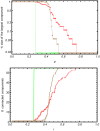Hierarchical organization of functional connectivity in the mouse brain: a complex network approach
- PMID: 27534708
- PMCID: PMC4989195
- DOI: 10.1038/srep32060
Hierarchical organization of functional connectivity in the mouse brain: a complex network approach
Abstract
This paper represents a contribution to the study of the brain functional connectivity from the perspective of complex networks theory. More specifically, we apply graph theoretical analyses to provide evidence of the modular structure of the mouse brain and to shed light on its hierarchical organization. We propose a novel percolation analysis and we apply our approach to the analysis of a resting-state functional MRI data set from 41 mice. This approach reveals a robust hierarchical structure of modules persistent across different subjects. Importantly, we test this approach against a statistical benchmark (or null model) which constrains only the distributions of empirical correlations. Our results unambiguously show that the hierarchical character of the mouse brain modular structure is not trivially encoded into this lower-order constraint. Finally, we investigate the modular structure of the mouse brain by computing the Minimal Spanning Forest, a technique that identifies subnetworks characterized by the strongest internal correlations. This approach represents a faster alternative to other community detection methods and provides a means to rank modules on the basis of the strength of their internal edges.
Figures







References
-
- van den Heuvel M. P. & Hulshoff Pol H. E.. Exploring the brain network: a review on resting-state fMRI functional connectivity. European Neuropsychopharmacology 20, 519–534 (2010). - PubMed
-
- Bullmore E. & Sporns O.. Complex brain networks: graph theoretical analysis of structural and functional systems. Nature Reviews Neuroscience 10, 186–198 (2010) (Date of access: 26/04/2016). - PubMed
Publication types
MeSH terms
LinkOut - more resources
Full Text Sources
Other Literature Sources

